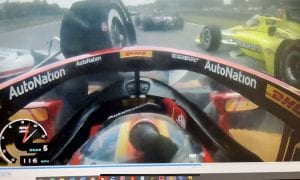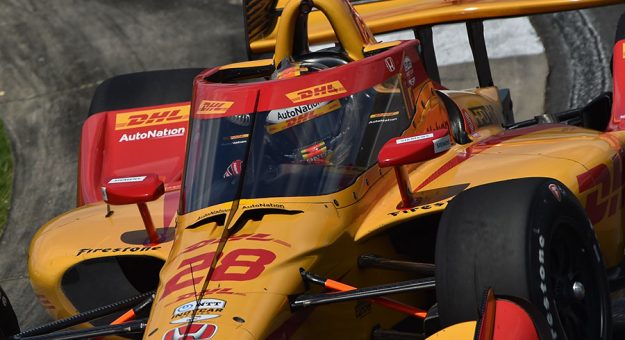ST. PETERSBURG, Fla. – IndyCar’s aeroscreen likely saved Andretti Autosport driver Ryan Hunter-Reay from serious injury in last Sunday’s first-lap crash during the Honda Indy Grand Prix of Alabama at Barber Motorsports Park.
Hunter-Reay’s No. 27 DHL Honda was one of several cars involved in a multi-car crash heading into turn five. Team Penske driver Josef Newgarden’s No. 2 Chevrolet was knocked into Hunter-Reay’s No. 27 DHL Honda after contact with Colton Herta’s No. 26 Honda. That sent Newgarden’s car over the front nose of Hunter-Reay’s machine with the right front wheel assembly hitting the aeroscreen.
If a similar crash had happened two years ago when the cockpits were completely open, Hunter-Reay’s helmet could have been exposed to potential contact.
Hunter-Reay didn’t realize how close he came to potential harm until he saw the in-car footage shot by Andretti Autosport. Hunter-Reay released screen shots of that footage on social media on Monday.
He explained in detail what happened in the incident to SPEED SPORT on Friday at the Firestone Grand Prix of St. Petersburg.
“Obviously, I didn’t see that situation coming, especially on the first lap of the first race of the season,” Hunter-Reay said. “I came to the top of the hill with a run behind Simon Pagenaud, I saw a bunch of dust, dirt being kicked up and I thought that was maybe somebody dropped their wheel. I continued on. I could see Newgarden’s car trending to the left. I thought things were OK. I could not see Colton Herta at that point. Colton impacted Josef, hitting him, sending Josef back into all the traffic that was coming, including myself.
“I knew it was going to be a big hit, braced for impact, closed my eyes and came out the other side thankfully, thanks to the aero screen.
“I really didn’t how it all went down until I looked at the video.”
Because Hunter-Reay’s eyes were closed on impact, he had a real eye-opener when he saw his onboard camera footage.

“I was pretty shocked that his entire right front assembly, tire, upright and everything hit the aeroscreen like that,” he said. “I was pretty shocked by that.”
Formula One cars use a halo device for driver cockpit protection. IndyCar’s aeroscreen uses a halo surrounded by high-strength Plexiglass.
“The structure itself did the job deflecting that,” Hunter-Reay said. “I’m convinced that with what was coming at the aeroscreen, if it had been a halo designed without the windscreen, other pieces of hardware would have come through and impacted me to some extent.
“To what extent, I’m not sure.”
Hunter-Reay admitted there were big scrapes from Newgarden’s wheel on his windshield and it completely pulled off the carbon fiber wicker that runs down the center of the aeroscreen.
In addition to keeping Hunter-Reay out of harm’s way, it also helped save the husband and father of three from potential serious injury.
“I just came out of thinking, I’m very grateful for the aeroscreen,” Hunter-Reay said. “That push and that drive from IndyCar to further driver safety and racing safety, this is a big implementation in the aeroscreen.”
The aeroscreen held up so well, Hunter-Reay is driving the same race car and using the same aeroscreen that was in the crash last week at Barber Motorsports Park. The car and screen were both sent to Dallara for inspection and no issues were discovered.
From a competitive standpoint, Hunter-Reay has some serious work to do, beginning with Sunday’s race on the streets of St. Petersburg, to climb back into contention. His last-place finish in the 24-car field puts him last in the NTT IndyCar Series standings with 15 races left in the season.
“That’s a hole we’re going to have to dig out of for quite a while,” Hunter-Reay said. “This is a great opportunity a few days later to be back on track and get some redemption. I love this place. I’ve had some great finishes here. I’m looking forward to the opportunity ahead.”
The competition isn’t getting easier, either, as evidenced by a talented group of young drivers, including last week’s race winner, 24-year-old Alex Palou of Spain.
Hunter-Reay enters the season 40 years old.
“I think there are a lot of kids that are fast right now,” he said. “There is a lot of talent in the series. Seasoned veterans as well as upcoming talent. It’s great time in the IndyCar Series and it’s surging in the right direction.”
He is hopeful the streets of St. Petersburg could return him to form, especially if he is able to claim his first win in this event.
“This is one of the mainstays, one of the Crown Jewels, on the IndyCar schedule,” Hunter-Reay said. “I finished second here a couple of times and on the podium quite a few times. This is on top of the list of the ones that I want to win.”
